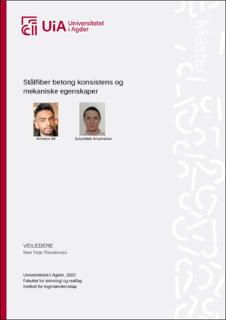| dc.description.abstract | In this era of rapid urban, the demand of concrete has also increased. This has given rise to more research on concrete performance and approach towards changes in concrete composition to fight global warming challenges. Addition of steel fiber has for many years been a pivotal point for researchers as a concrete performance enhancing adhesive. Steel fibers can also be added in concrete as a cement replacing adhesive, thus reducing CO_2 releases in the atmosphere.
It has been established that steel fibers reduce workability and consistency in concrete. On the other side, it also improves mechanical behavior in concrete and increase the lifetime of concrete. Residual flextural performance has been an interesting research topic for concrete as to understand and investigate behavior of steel fiber reinforced concrete after fracture. This brings us to the research question of this master`s thesis “How does different steel fiber volume fractions and fiber geometry effect the workability and mechanical properties in concrete”. The research question was sub-divided into several methods that were utilized to answer the research question.
Different volume fractions of 0,33%, 0,66% and 1% were chosen along with 4D and 5D steel fiber types with similar aspect ratios. Slump flow test, LCPC box and rheometer test were chosen to investigate the rheological properties of steel fiber reinforced concrete. Compression test, elasticity module test and flexural test were used to determine the mechanical properties of the concrete.
The slump-flow test results indicated decrease in concrete workability with increase in steel fiber volume fractions. The decrease in workability with increasing steel fiber content was also observed for LCPC-box and rheometer test results. The reduction in workability for 4D fiber type concrete was higher than 5D fiber type.
Compression test, elasticity module and residual flexural results showed increase in compressive strength with increase in steel fiber content for both 4D and 5D fiber types. Comparison between the effect of elasticity module for 4D and 5D fibers was inclusive due to low sample size. 4D fiber results showed high compressive strength and 5D fibers, whereas 5D fiber demonstration better results than 4D fiber for the residual flexural strength test.
Based on the results mentioned hereinabove, it can be concluded that concrete reinforcement with steel fibers reduces workability in concrete. Increase in steel fiber content increased elasticity module, but future studies should consider testing more samples for a better conclusion. Residual flexural strength also increases with increase in steel fiber volume fraction, which goes on to answer the research question about effect of steel fiber volume fraction on mechanical properties of concrete. | |
